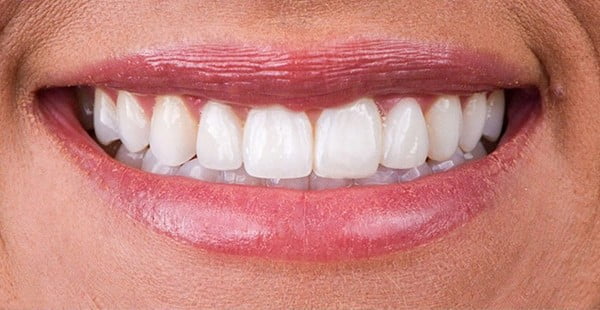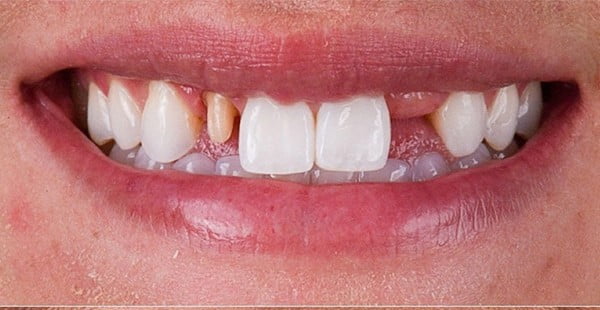Dentures are dental structures that replace teeth. Dentures restore the dental anatomy and physiology and bring back a beautiful smile. Properly made dentures don’t cause any discomfort, the patient almost immediately begins to feel them as his/her own teeth. Artificial teeth can be made to be more perfect than the natural ones.
Dentures are used for both full and partial absence of teeth. Modern orthopedic dentistry offers a wide range of dentures made of different materials.
Dentures are distinguished between removable and permanent types according to its structure
- Permanent dentures are fixed firmly, and cleaning them is no different than brushing of regular teeth. Today this option is the most convenient one, especially when it comes to the restoration of single teeth.
- Removable dentures can be inserted or removed by patient, and after removal the dentures can be cleaned and food debris can be removed.
Dental crowns and tooth bridges
Crown is a prosthetic tooth. Crown replicates tooth anatomic shape and allows to restore its masticatory function. The crown is attached to the damaged tooth and prevents it from further decay. Crowns can be a single tooth, or they can be fused artificial teeth that will be called a bridge.
Metal ceramic crowns are constructions that consist of metal base on which ceramic mass of real tooth color is applied. This type of crown is very durable. Because of the metal structure underneath the layer of ceramic, the color of the structure may not match natural teeth under different lights. The presence of metal in the mouth may have negative impact on the oral health, because metal ions have irritant effect on the body and can cause allergic reactions. Metal ceramic crowns are indicated for a single tooth restoration or in case of increased load on long bridge (more than 4 crowns in bridge), if the requirements for aesthetics take second place to durability.
Modern alternative to metal-ceramic is zirconia crowns, which have a number of additional advantages and exclude negative factors connected with metal.
Zirconia crowns are made of zirconium dioxide and covered with ceramic. They are fully biocompatible with human tissues, non-allergenic, lightweight, strong and aesthetically superior to any other crown.
Zirconium dioxide is the «treasure of dentistry» and one of the most innovative materials for artificial teeth. It is as similar to the features of natural tooth tissue as possible: it has snow-white shade, is slightly transparent and extremely durable. Zirconia crowns are used both for single restorations and implant restorations as part of dental bridges consisting of more than 10 consecutive dental crowns. In modern prosthetics it is the most effective method of tooth restoration.
The frameworks of prosthetic constructions based on this material are very thin and are only 0.5 millimeters thick. This also reduces the degree of tooth grinding. The zirconia material has very low thermal conductivity and that solves the problem of tooth sensitivity. Therefore, the sensitivity threshold significantly improves with metal-free crowns.
Ceramic crowns are made of pressed glass-ceramic with the addition of leucite crystals, which significantly strengthens the construction. Ceramic crowns do not differ from real teeth in appearance and do not lose their original brightness after many years. They are strong enough and perform well in front teeth, but are more brittle than zirconia crowns, so they are not recommended for masticatory teeth. Ceramics are fully biocompatible with natural tissues in the mouth, and do not cause allergic reactions
Not only crowns but also partial dentures, inlays, veneers and lumineers can be made of all-ceramic. This refers only to the amount of tissue that remains after the preparation of the tooth. Ceramics can keep a tooth «alive» even if most of it is missing.
Treatment involves two visits. At the first visit, all the decayed tissue is removed, and the doctor takes an impression of the upper and lower jaw in order to send this form to the laboratory. The technician makes the missing parts of the tooth on a plaster model of the jaw.
At the second visit, a ceramic inlay is tested, and the patient sees its shape and color. If everything is satisfactory, then the ceramic filling is firmly attached to the light-cured cement, which is much stronger in bonding strength to the tooth than a regular light cure filling.
Shape of such inlays on the masticatory surface is always of relief. This is done for a better grinding of food and a perfect occlusion of the teeth. If the load on the teeth is balanced, it is a good prevention of diseases of the temporomandibular joint (TMJ). Patients often deal with the symptoms of TMJD (clicking, crunching, painful opening or closing of the mouth).
Removable prosthetics
This type of prosthetics is considered a temporary stage, as modern implant prosthetics allows you to completely replace removable dentures. The disadvantage of this technique is that there is no complete chewing process, all the pressure from the grinding of food is transferred to the gum. Over time, bone and mucosal atrophy occurs. Prosthesis is poorly fixed, requires the preparation of supporting teeth, and also takes large area in the mouth, as it is shaped like a saddle, so it is possible to have a support under it in the form of edentulous mucosa area.




